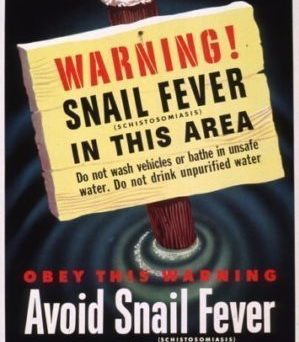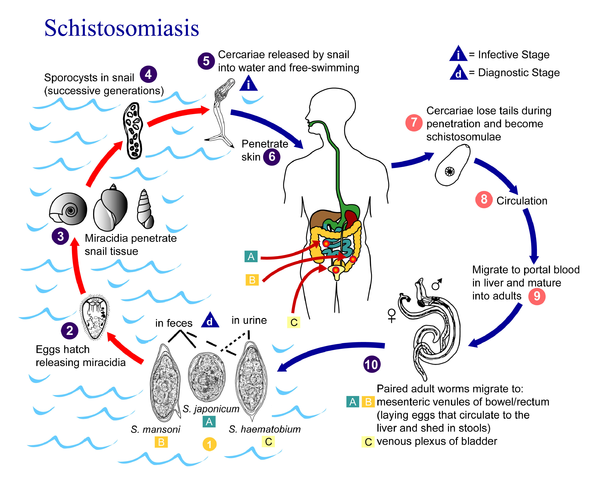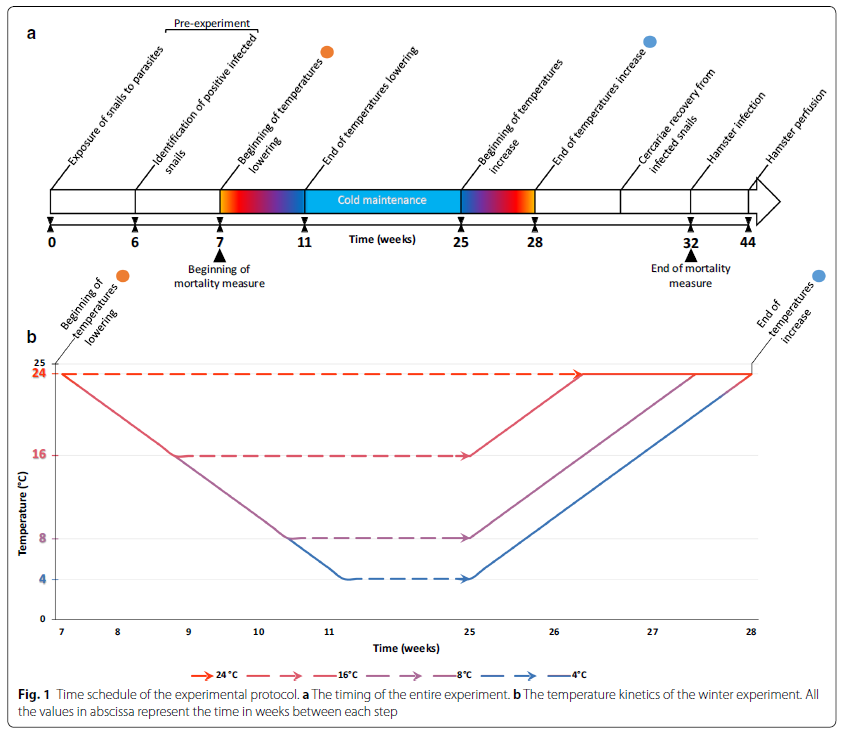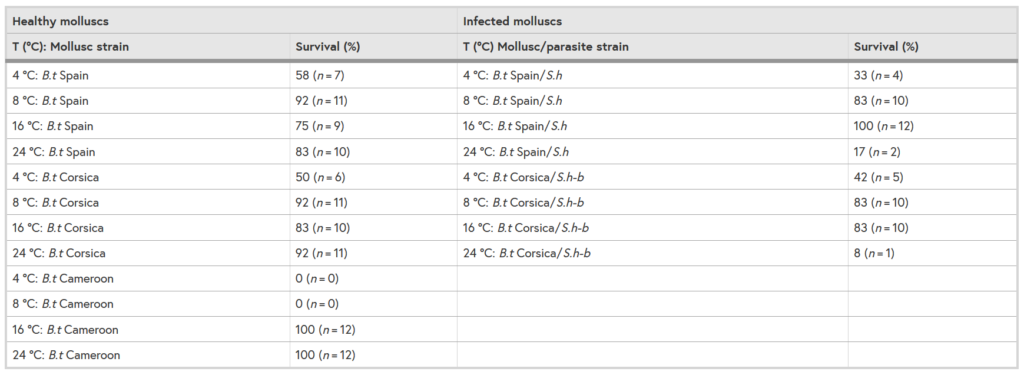
(Image source: flickr)
Background on schistosomiasis
Schistosomiasis, also known as snail fever or bilharzia, is an infection caused by parasitic blood flukes endemic to subtropical and tropical regions. Transmission occurs in 78 countries, with 52 countries having moderate-to-high transmission requiring preventive treatment to reduce and prevent morbidity. Over 220.8 million people needed preventive treatment in 2017, with at least 90% living in Africa.
The two major forms of disease are intestinal and urogenital schistosomiasis and these are mainly caused by five Schistosoma species. Schistosomiasis primarily affects poor and rural communities where people are regularly exposed to infested water, such as during domestic, occupational and recreational activities.

Infection occurs when parasite larval forms leave freshwater snails, their intermediate host, and penetrate human skin in infested water. The larvae develop into adult schistosomes that live in the blood vessels where the females release eggs. The eggs are excreted through feces or urine and hatch in water, contaminating freshwater sources and leading to onward transmission.
Some eggs also become lodged in body tissues, causing inflammatory responses and progressive organ damage that can result in death.
Schistosomes on permanent vacation?
Both environmental and anthropogenic changes may influence the emergence and spread of infectious diseases worldwide. Of particular concern is the migration of tropical infectious diseases to more temperate regions. However, tropical diseases reliant on hosts with limited dispersal, such as snails, would appear to be less threatening.
It was therefore surprising when cases of urogenital schistosomiasis were diagnosed in French and German hospitals in 2014. Oddly, these European patients had never visited schistosomiasis endemic areas and all patients were infected in August 2013 in Corsica, a French Mediterranean Island.
Urogenital schistosomiasis is caused by Schistosoma haematobium, and freshwater snails in the genus Bulinus act as intermediate hosts. A large diagnostic campaign identified 106 cases of urogenital schistosomiasis linked to water contact on the Cavu River in southern Corsica, where Bulinus truncates was present.

New cases of local infections were identified in the summers of 2015 and 2016, suggesting transmission was ongoing and established in Corsica. The schistosome strain was identified as a hybrid lineage from interbreeding between S. haematobium and S. bovis (a ruminant-associated schistosome species).
Possible explanations for the persistence of schistosomes in temperate latitudes included:
- Adult parasites survive in their human hosts during winter and transmission persists through annual release of schistosome eggs from infected individuals.
- Local snail hosts and infecting schistosome larvae survive in winter temperatures, and larvae can complete their life cycle after wintering.
This 2nd hypothesis was recently investigated in an ecological experiment by Mulero and colleagues. The researchers aimed to quantify the survival of healthy and infected snails, as well as schistosome strains within their hosts, under winter conditions. They also sought to determine whether schistosomes could complete their life cycle after overwintering.
Snail survival and pre-adaptation of schistosomes to overwinter
The authors measured the life history traits of different Bulinus/Schistosoma strain pairings, including:
- Bulinus (B.t) from tropical and temperate countries (Cameroon, Spain and Corsica) to test for local adaptation in temperate regions.
- Two S. haematobium (S.h) strains (pure S. haematobium from Cameroon or S. haematobium-bovis hybrids from Corsica) to test for any parasite strain effects on both the snail and the schistosome survival in relation to cold stress.
Batches of non-exposed snails from Cameroon, Corsica and Spain were also maintained.
Experimental temperatures were selected to mirror the thermal dynamics measured at Cavu River. Temperature experiments consisted of:
- A progressive decrease in temperature over 4 weeks
- A long-term maintenance at specific “winter temperature” for 14 weeks
- A progressive increase in temperature over 3 weeks
- Larval shedding from snails checked for a further 4 weeks

One control temperature (24 °C), optimal for snail and schistosome development, and three “winter temperatures” (4, 8 and 16 °C) were tested for each infection. The snails were individually checked for larval shedding after returning to 24 °C, and pooled larvae from the S.h Corsican strain maintained at 8 °C were used to infect hamsters. Adult schistosomes were recovered from their mammal host after 90 days.

Schistosomiasis in Europe: the next installment
The authors discovered that the Mediterranean B. truncatus strain (i.e. Spain, Corsica) can survive during a long-term cold period, and they are better adapted to winter conditions compared to tropical B. truncatus (i.e. Cameroon). Infected snails also displayed a higher survival rate at cold temperature than at the higher ‘optimal’ temperature.
Further, both schistosome strains equally survived cold stress when infecting temperate snails and produced offspring after returning to optimal temperatures, irrespective of the winter temperature they had been maintained at. The S.h-b Corsican strain larvae maintained at 8 °C also successfully developed into adult worms within their hamster hosts. These findings signal that schistosomes can overwinter in temperate climates, which may in part account for schistosome establishment and maintenance in Corsica.

Mulero et al have demonstrated that the thermal range of schistosomes is surprisingly broader than that of their local snail hosts. Therefore, the dispersal and establishment of schistosomiasis in temperate regions seems to rely on locally adapted snail host strains, which are currently known to persist in France, Italy, Portugal, Spain and Greece.
The emergence of a tropical snail-borne disease in Corsica was an unexpected finding in 2014, but do these results suggest schistosomiasis could soon be coming to a river near you?

Comments